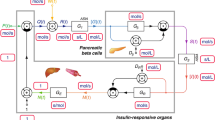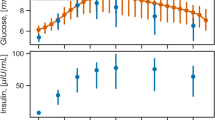Abstract
Bayesian approaches to model identification [e.g., maximum a posteriori (MAP) estimation] are receiving increasing attention in metabolism since important quantitative knowledge has become available in the last decades, e.g., from tracer experiments. By suitably exploiting this knowledge, more complex physiological models than those solely based on experimental data (Fisherian approach) become resolvable. While ADAPT II is the reference software for MAP estimation in pharmacokinetic/pharmacodynamic/metabolic system analysis, another popular, user-friendly and state-of-the-art software is SAAM II. However, SAAM II does not handle a priori information on correlation among parameters, thus allowing a limited version of MAP estimation to be performed. The aim here is twofold. First, we show that this limitation of SAAM II can be easily overcome by resorting to a probability theory result. Second, we test SAAM II vs ADAPT II implementation of MAP estimation in a real case study: the Bayesian identification of a recently proposed two-compartment minimal model of glucose kinetics during an intravenous glucose tolerance test. SAAM II MAP estimates of glucose effectiveness(SG)and insulin sensitivity(SI)obtained in a group of 22 healthy humans are in excellent agreement with those of ADAPT II: S G=2.84±0.27 vs. 2.84±0.27 (ml-min−1kg−1, mean±SD) and S I=11.46±1.69 vs. 11.47±1.69 [10-2ml kg-1,min-1/(µU ml-1)]. The SAAM II vs. ADAPT II estimates are virtually identical (P > 0.44 and 0.68 for S G and S I, respectively) and also closely correlated (ρ=0.9998 and 0.9999). © 2002 Biomedical Engineering Society.
PAC2002: 8710+e, 0250Cw
Similar content being viewed by others
REFERENCES
Anderson, R. L., R. F. Hamman, P. J. Savage, M. F. Saad, A. Laws, W. W. Kades, R. E. Sands, and W. Cefalu. Exploration of simple insulin sensitivity measures derived from frequently sampled intravenous glucose tolerance (FSIGT) tests. The insulin resistance atherosclerosis study. Am. J. Epidemiol. 142:724-732, 1995.
Barrett, P. H. R., B. M. Bell, C. Cobelli, H. Golde, A. Schumitzky, P. Vicini, and D. M. Foster. SAAM II: Simulation, analysis, and modeling software for tracer and pharmacokinetic studies. Metabolism 47:484-492, 1998.
Bergman, R. N., Y. Z. Ider, C. R. Bowden, and C. Cobelli. Quantitative estimation of insulin sensitivity. Am. J. Physiol. 236:E667-E677, 1979.
Best, J. D., S. E. Kahn, M. Ader, R. M. Watanabe, T.-C. Ni, and R. N. Bergman. Role of glucose effectiveness in the determination of glucose tolerance. Diabetes Care 9:1018-1030, 1996.
Carson, E. R., C. Cobelli, and L. Finkelstein. The Mathematical Modeling of Metabolic and Endocrine Systems. New York: Wiley, 1983.
Cobelli, C., F. Bettini, A. Caumo, and M. J. Quon. Overestimation of minimal model glucose effectiveness in presence of insulin response is due to undermodeling. Am. J. Physiol. 275:E1031-E1036, 1998.
Cobelli, C., A. Caumo, and M. Omenetto. Minimal model SG overestimation and SI underestimation: Improved accuracy by a bayesian two-compartment model. Am. J. Physiol. 277:E481-E488, 1999.
D'Argenio, D., and A. Schumitzky. ADAPT II User's Guide: Parmacokinetic/Pharmacodynamic System Analysis Software. Release 4. In: The Biomedical Simulation Resource. Los Angeles, CA: University of Southern California Press, 1997.
Finegood, D. T., and D. Tzur. Reduced glucose effectiveness associated with reduced insulin release: An artifact of the minimal model method. Am. J. Physiol. 271:E485-E495, 1996.
Johnson, R. A., and D. A. Wichern. Applied Multivariate Statistical Analysis. Englewood Cliffs, NJ: Prentice Hall, 1998.
Magni, P., R. Bellazzi, G. Sparacino, and C. Cobelli. Bayesian identification of a population compartmental model of c-peptide kinetics. Ann. Biomed. Eng. 28:812-823, 2000.
Quon, M. J., C. Cochran, S. Y. Taylor, and R. C. Eastman. Noninsulin-mediated glucose disappearance in subjects with IDDM. Discordance between experimental results and minimal model analysis. Diabetes 43:890-896, 1994.
Reaven, G. M. Banting lecture. Role of insulin resistance in human disease. Diabetes 37:1595-1607, 1988.
Saad, M. F., R. L. Anderson, A. Laws, R. M. Watanabe, W. W. Kades, Y. D. Chen Ida, R. E. Sands, D. Pei, P. J. Savage, and R. N. Bergman for the IRAS. A comparison between the minimal model and the glucose clamp in the assessment of insulin sensitivity across the spectrum of glucose tolerance. Diabetes 43:1114-1121, 1994.
SAAM II User Guide. Seattle, WA: SAAM Institute, 1997.
Sparacino, G., C. Tombolato, and C. Cobelli. Maximumlikelihood versus maximum a posteriori parameter estimation of physiological system models: The c-peptide impulse response case study. IEEE Trans. Biomed. Eng. 47:801-811, 2000.
Walter, E., and L. Pronzato. Identification of Parametric Models from Experimental Data. Paris: Springer, 1997.
Author information
Authors and Affiliations
Rights and permissions
About this article
Cite this article
Callegari, T., Caumo, A. & Cobelli, C. Generalization of Map Estimation in SAAM II: Validation Against ADAPT II in a Glucose Model Case Study. Annals of Biomedical Engineering 30, 961–968 (2002). https://doi.org/10.1114/1.1507328
Issue Date:
DOI: https://doi.org/10.1114/1.1507328




